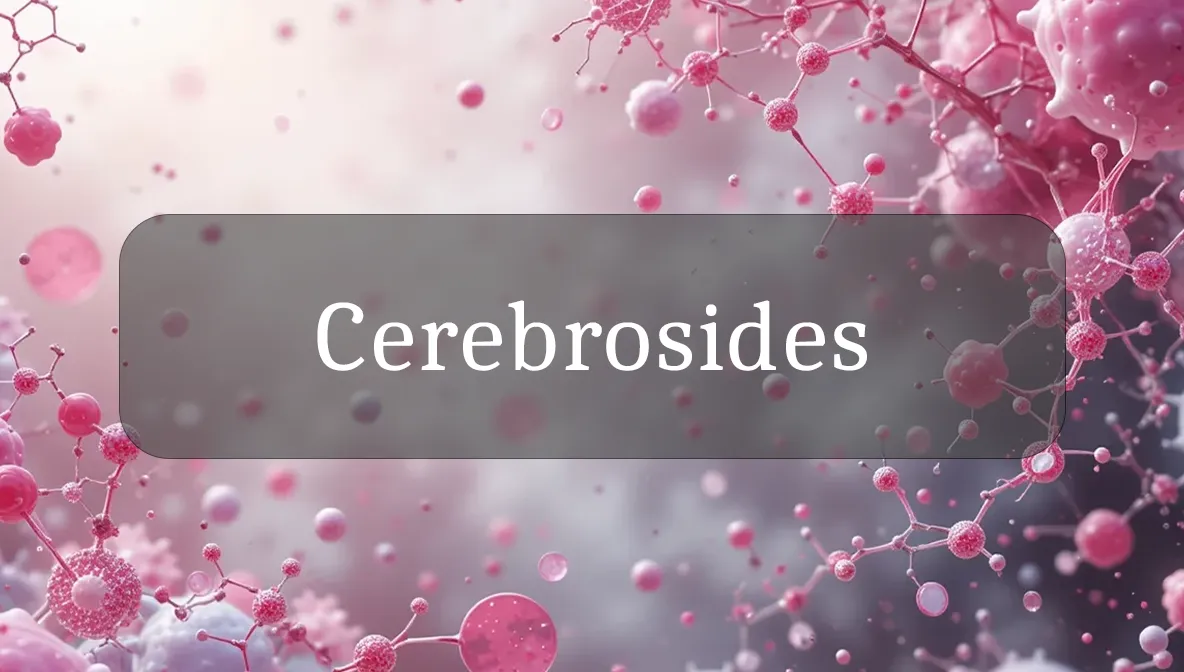Nervous System’s Lipid Protectors for Brain and Nerve Health
Cerebrosides are like the insulating shields of your nervous system, specialized lipids that support nerve function, brain health, and cell membrane stability. Found primarily in the myelin sheath of nerves and brain tissue, they’re a key focus for health-conscious folks aiming to maintain cognitive sharpness and neurological wellness. Understanding cerebrosides can empower you to make choices that nurture your brain and nerves. Let’s explore what cerebrosides are, why they matter, and how you can support their function for daily vitality!
Chemical Identity and Type
Cerebrosides are glycosphingolipids, composed of a ceramide (sphingosine plus a fatty acid) linked to a single sugar molecule, typically galactose (galactocerebrosides) or glucose (glucocerebrosides). They’re synthesized in the endoplasmic reticulum and Golgi apparatus, primarily in neural tissues, and are abundant in the myelin sheath (20–25% of myelin lipids). The most common cerebroside, galactocerebroside (GalCer), is critical for nerve insulation. Think of cerebrosides as the protective coating on your body’s electrical wiring, ensuring efficient nerve signaling.
Biological Role and Benefits
Cerebrosides are essential for neurological function and cellular health, offering these evidence-based benefits:
- Myelin Sheath Stability: They form a key component of myelin, insulating nerves to speed up signal transmission, supporting movement, and cognition.
- Brain Health: Cerebrosides maintain neuronal membrane integrity, aiding memory, learning, and brain cell communication (studies link GalCer to synaptic stability).
- Immune Regulation: They modulate immune responses in the brain, reducing neuroinflammation and protecting against autoimmune disorders like multiple sclerosis.
- Cell Signaling: Cerebrosides act as receptors or signaling molecules, facilitating cell-to-cell interactions in neural and immune tissues.
- Tissue Protection: They contribute to the structural integrity of skin and other tissues, supporting barrier function alongside other lipids.
Healthy cerebroside levels promote sharp cognition, efficient nerve function, and resilient tissues, enhancing overall vitality.
Dietary or Natural Sources
Your body synthesizes cerebrosides, particularly in the brain and nervous system, but dietary sources can provide precursors like sphingosine or fatty acids. Include these foods to support cerebroside production:
- High Sphingolipid Precursor Foods:
- Egg yolk (50–100 mg/kg sphingolipids)
- Whole milk (10–20 mg/L sphingolipids)
- Beef liver (100–200 mg/kg)
- Fish roe (20–50 mg/kg)
- Chicken liver (50–100 mg/kg)
- Moderate Precursor Foods:
- Dairy products (cheese, butter; 5–10 mg/100 g)
- Soybeans (10–20 mg/kg sphingolipids)
- Peanuts (5–10 mg/100 g)
- Supplements: Sphingolipid-enriched extracts (e.g., from milk or soy) are rare but available for research or neurological support; evidence for efficacy is limited.
- Plant-Based Note: Plants contain minimal sphingolipids, but soy, corn, and mushrooms provide small amounts of ceramide precursors.
A varied diet with animal-based or soy foods supports cerebroside synthesis indirectly.
Signs of Imbalance or Dysfunction
Cerebroside imbalances, often due to genetic disorders or aging, may show up as:
- Neurological Decline: Tremors, muscle weakness, or cognitive impairment from myelin breakdown, seen in leukodystrophies like Krabbe disease (1 in 100,000 prevalence).
- Nerve Dysfunction: Numbness, tingling, or slowed reflexes from impaired myelination, potentially linked to multiple sclerosis or peripheral neuropathy.
- Cognitive Issues: Memory loss or difficulty concentrating, as cerebroside loss disrupts neuronal signaling (e.g., in Alzheimer’s models).
- Skin Barrier Weakness: Dryness or sensitivity from reduced cerebrosides in skin cell membranes, though less common.
- Rare Metabolic Disorders: Gaucher’s disease (glucocerebroside buildup, 1 in 40,000) causes fatigue, bone pain, or organ enlargement.
These symptoms can have many causes, so consult a healthcare provider for neurological or metabolic evaluation.
Supporting Optimal Levels or Function
To enhance cerebroside synthesis and function, try these evidence-based tips:
- Eat Nutrient-Dense Foods: Include eggs, dairy, or fish to provide sphingolipid precursors and omega-3s, supporting myelin and brain health.
- Boost Fatty Acid Intake: Consume healthy fats (avocado, nuts, olive oil) to supply fatty acids for ceramide synthesis, a cerebroside building block.
- Exercise Regularly: Moderate activities like walking or swimming (30 min/day, 5 days/week) improve cerebral blood flow, supporting cerebroside-rich neurons.
- Protect Brain Health: Eat antioxidant-rich foods (berries, leafy greens) to reduce oxidative stress, preserving cerebroside function in nerves.
- Support Gut Health: Include probiotic foods (yogurt, kefir) to enhance gut-brain axis signaling, potentially aiding neural lipid metabolism.
Small, consistent habits create a cerebroside-friendly environment for brain and nerve health.
Safety, Interactions, and Precautions
Cerebrosides are natural lipids and safe at physiological levels, but consider these factors:
- Genetic Disorders: Krabbe or Gaucher’s disease involves cerebroside metabolism defects, requiring specialized medical care; dietary changes won’t treat these.
- Supplements: Sphingolipid or cerebroside supplements are experimental with limited human data; avoid unless prescribed by a healthcare provider.
- Allergies: Dairy or egg-based sources may cause reactions in sensitive individuals (1–2% of adults). Opt for soy or fish alternatives.
- Neurological Conditions: Diseases like multiple sclerosis or Alzheimer’s may involve cerebroside dysregulation; medical management is essential.
- High-Fat Diets: Excessive saturated fats may disrupt lipid metabolism, potentially affecting cerebroside balance. Prioritize healthy fats.
Moderation and a balanced diet maximize cerebroside benefits with minimal risk.
Fun Fact
Did you know cerebrosides are the secret to your nerves’ super-speed? They make up part of the myelin sheath, which can boost nerve signal speed up to 100 meters per second, like a biological superhighway!
Citations
- National Institutes of Health (NIH): Sphingolipids and Neurological Health.
- Mayo Clinic: Myelin and Nerve Function.
- Cleveland Clinic: Nutrition and Brain Wellness.
- World Health Organization (WHO): Diet and Neurological Health Guidelines.
- USDA: Dietary Guidelines for Americans – Nutrient-Dense Diets.

